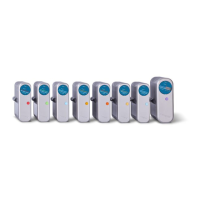ENGINEERING MANUAL OF AUTOMATIC CONTROL
CHILLER, BOILER, AND DISTRIBUTION SYSTEM CONTROL APPLICATIONS
360
Fig. 87. Two-Pipe Direct-Return System.
Primary-Secondary Pumping
Primary-secondary pumping allows water temperature and
on/off times of each secondary zone to be independently
controlled. The main supply pump uses less power in this
arrangement since it is sized to handle only main pressure losses.
Secondary pumps handle only the zone piping losses.
Figure 88 shows common configurations for primary-
secondary pumping. The three-way valve configuration
provides more positive control than the two-way valve.
LOAD
LOAD
LOAD
LOAD
LOAD
LOAD
LOAD
LOAD
LOAD
LOAD
EXPANSION TANK
BOILER
OR
CHILLER
SUPPLY
RETURN
C2835
Fig. 88. Piping for Primary-Secondary Pumping.
BOILER
LOAD
LOAD
T
T
PRIMARY
PUMP
ZONE PUMP
ROOM
THERMOSTAT
ROOM
THERMOSTAT
ZONE WITH 2-WAY VALVE
OTHER
ZONES
ZONE WITH 3-WAY VALVE
BALANCING
VALVE
ZONE PUMP
M10485
A converter (heat exchanger) shown in Figure 89 can be used
in large or high rise buildings to reduce the zone temperature/
pressure requirements from those of the mains.
EXPANSION TANK
CONVERTER
HIGH OR MEDIUM
TEMP MAINS
RETURN
SUPPLY
C2915-1
LOAD
LOAD
LOAD
LOAD
Fig. 89. Converter Used to Supply
Zones from a Larger System.
CONTROL OF HOT WATER SYSTEMS
General
Heating (terminal) units used in hot water heating systems are:
— Radiant Panels
— Radiators or finned tubes
— Forced air heating coils
Control of heat output from a heating unit can use one or a
combination of the following methods:
— On-off control, by starting and stopping a pump or
opening and closing a valve
— Modulating flow control
— Supply water temperature control
Modulating Flow Control
Varying water flow to finned tube radiation or a heating coil,
each supplied with constant temperature hot water, is shown
graphically in Figures 90 and 91.
In both cases, reducing flow 75 percent reduces the heat
output only 30 percent because as flow is reduced, more heat is
extracted from each liter of water. At low flows leaving water
temperature decreases sharply (Fig. 91). At light loads
modulating flow control by itself is not the best means of
controlling heat output.

